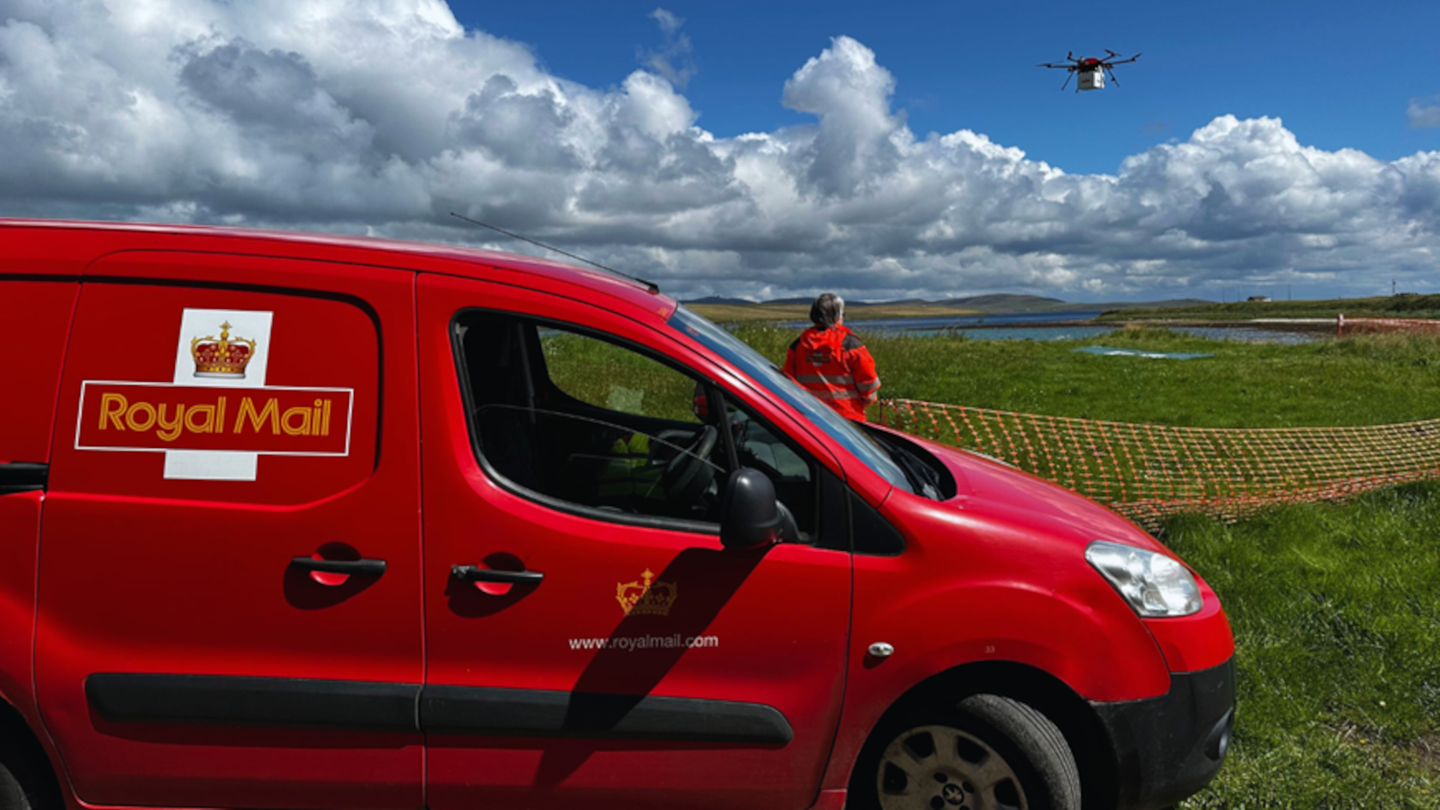UK’s Royal Mail Launches Drone Delivery to Remote Scottish Islands
The service will initially operate for three months but is expected to become the country’s first permanent drone delivery operation.

A Royal Mail postal worker watches a drone fly a parcel over the Orkney Islands in Scotland. [Courtesy: Royal Mail]
You can’t deliver mail in a maelstrom. That’s the unique problem facing island communities off the U.K. coast that must contend with service disruptions whenever poor weather derails ferry routes. But the challenge could be solved by a groundbreaking new service.
Royal Mail, the U.K.’s oldest parcel carrier, and Skyports Drone Services, the cargo delivery arm of drone infrastructure provider Skyports, on Tuesday announced the launch of a drone delivery project on the Orkney Islands, north of the Scottish coast. The service is initially slated for a three-month trial but is expected to become the country’s first permanent drone delivery operation under current regulatory frameworks.
“We are proud to be working with Skyports to deliver via drone to some of the more remote communities that we serve in the U.K.,” said Chris Paxton, head of drone trials at Royal Mail. “Using a fully electric drone supports Royal Mail’s continued drive to reduce emissions associated with our operations, whilst connecting the island communities we deliver to.”
The Orkney I-Port operation launched in July as a collaboration between Royal Mail, Skyports, the Orkney Islands Council Harbour Authority, and Scottish regional airline Loganair. The daily mail distribution service currently flies between three islands.
Letters and parcels are transported from Royal Mail’s Kirkwall delivery office to the town of Stromness, where Skyports delivers them to Royal Mail staff on the islands of Graemsay and Hoy via drone. Postal workers then collect the cargo and follow their normal delivery routes.
The weather and landscape of the Orkney Islands can impede traditional delivery methods like ferries. But Royal Mail says the geography also allows the company to conduct extended visual line of sight flights with less remote oversight than would typically be required.
The flights mark the first operation between Skyports and its partner, São Paulo-based Speedbird Aero. The partners will deploy Speedbird’s DLV-2 multirotor drone, which has a payload capacity of 35 pounds and a range of about 10 sm (8.7 nm). In addition to being able to fly in harsh weather, the drone figures to improve delivery speed and reduce emissions.
“By leveraging drone technology, we are revolutionizing mail services in remote communities, providing more efficient and timely delivery, and helping to reduce the requirement for emissions-producing vehicles,” said Alex Brown, director of Skyports Drone Services.
For the first three months of the project, costs will be covered by the U.K. Department of Transport’s Freight Innovation Fund. After that, though, the partners will be on their own.
The Next Generation of Parcel Delivery
For remote island communities like Orkney, drones represent a potential game-changer for delivery of mail and crucial items like medical supplies. The concept is one Royal Mail has now pursued for years.
In 2020, the company partnered with a consortium of U.K. drone firms and became the country’s first parcel carrier to complete a drone delivery that December. The following May, it ramped up those efforts with autonomous drone parcel delivery and inter-island test kit delivery trials to the Isles of Scilly. And in October 2021, it successfully completed yet another drone initiative, this time a two-week autonomous trial between the Orkney Islands.
In May 2022, Royal Mail announced its short-term vision: 50 postal drone routes launched over the next three years in partnership with drone logistics provider Windracers Group. The Orkney Islands and Isles of Scilly were proposed as initial sites alongside the Hebrides and Shetland Islands. Routes will at first be supported by up to 200 drones, but the ultimate goal is to deploy as many as 500.
Royal Mail is also reducing its fleet emissions by electrifying its ground transport. In 2021, it announced an initiative to ensure all company cars will be 100 percent electric by 2030. It provided an update on that effort in July, revealing that its delivery fleet already includes 5,000 electric vans.
Like this story? We think you'll also like the Future of FLYING newsletter sent every Thursday afternoon. Sign up now.

Subscribe to Our Newsletter
Get the latest FLYING stories delivered directly to your inbox






